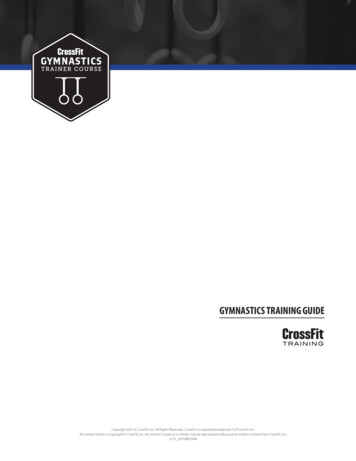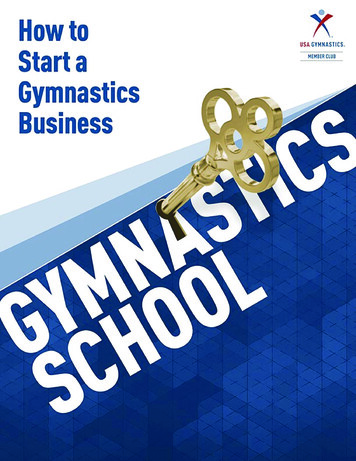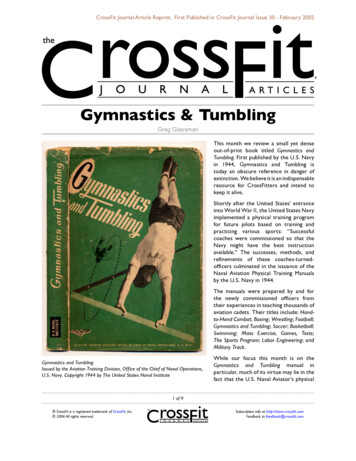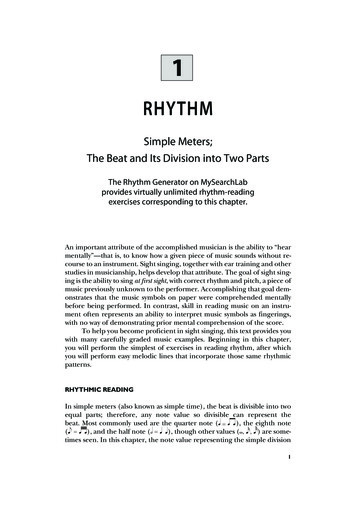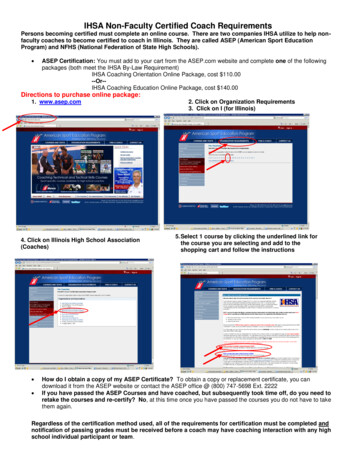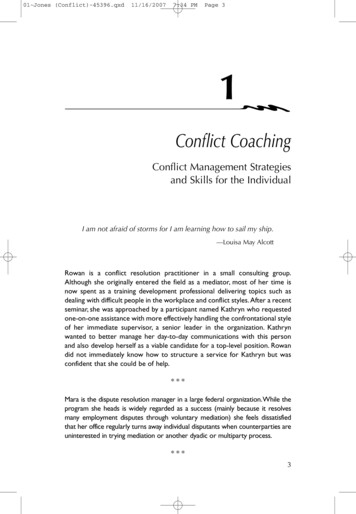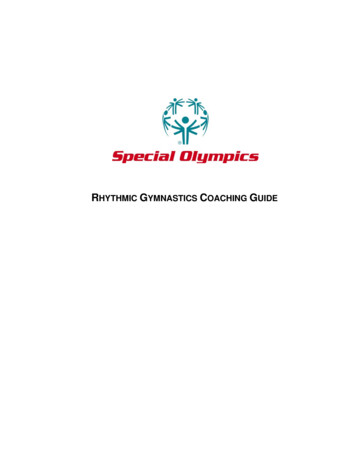
Transcription
RHYTHMIC GYMNASTICS COACHING GUIDE
Special Olympics Rhythmic Gymnastics Coaching GuideAcknowledgementsAcknowledgementsSpecial Olympics wishes to thank the professionals, volunteers, coaches and athletes who helped in the production ofthe Rhythmic Gymnastics Coaching Guide. They have helped fulfill the mission of Special Olympics: to provide yearround sports training and athletic competition in a variety of Olympic-type sports for people 8 years of age and olderwith intellectual disabilities, giving them continuing opportunities to develop physical fitness, demonstrate courage,experience joy and participate in a sharing of gifts, skills and friendship with their families, other Special Olympicsathletes and the community.Special Olympics welcomes your ideas and comments for future revisions of this guide. We apologize if, for anyreason, an acknowledgement has been inadvertently omitted.Contributing AuthorsCindy Bickman, Special Olympics, Inc. – Rhythmic Gymnastics Technical DelegateJoey Burgess, Rhythmic Gymnastics Sport Resource Team MemberJessica Israel-Hiles, Rhythmic Gymnastics Sport Resource Team MemberRosie Lambright, Rhythmic Gymnastics Sport Resource Team MemberRyan Murphy, Special Olympics, Inc.Juliane Sanders, Rhythmic Gymnastics Sport Resource Team MemberKatie Scott, Rhythmic Gymnastics Sport Resource Team MemberAshley Thompson, Rhythmic Gymnastics Sport Resource Team MemberSpecial Thanks To the Following for All of Your Help and SupportSailaja AkunuriFloyd Croxton, Special Olympics, Inc., AthleteDave Lenox, Special Olympics, Inc.Matt McGarraghyKristi SkeboBecky Turner BucklandPaul Whichard, Special Olympics, Inc.Special Olympics GeorgiaSpecial Olympics North AmericaVideo Clips Starring Athletes from Special Olympics Georgia – Cobb CountyGabby AllenAlex BeachKatie BenderBret BrannanCasey BrennanJennifer CampbellCathy CantrellTori ClarkMaryLynn CollinsKaren DavisLani DeMelloChloe DillardMichelle FlakeGretchen FuchsVanessa Futral2Special Olympics Rhythmic Gymnastics Coaching Guide- August 2008
Special Olympics Rhythmic Gymnastics Coaching GuideAcknowledgementsMorgan GalvinKhalilah GreerAshley GuyAllison HalePaulette HarrisonAdrienne HolladaySarah JonesNoel KeilhauerKatie KludtDana MisitanoAllyson NixStephanie O’ConnorMegan RatliffStephanie RiosLeslie TedeschiVideo Clips Starring Unified PartnersKatie HamAli LambrightVideo Clips Starring Coaches from Chattooga GymnasiumCindy BickmanJoey BurgessJessica Israel-HilesRosie LambrightJuliane SandersKatie ScottAshley ThompsonSpecial Olympics Rhythmic Gymnastics Coaching Guide- August 20083
RHYTHMIC GYMNASTICS COACHING GUIDEPlanning a Rhythmic Gymnastics Training &Competition Season
Special Olympics Rhythmic Gymnastics Coaching GuidePlanning a Rhythmic Gymnastics Training & Competition SeasonTable of ContentsGoalsBenefits of Goal SettingGoal Setting and MotivationEssential Components of a Rhythmic Gymnastics Training SessionWarming UpSkills InstructionCompetition ExperienceCooling DownConsiderations for TrainingPreparing for a Training SessionYour Training PlanEquipment SetupPrinciples of Effective Training SessionsTips for Conducting Successful Training SessionsTips for Conducting Safe Training SessionsNutritionGuidelines for a Balanced DietPre-Competition Meal/NutrientsDuring Competition NutrientsPost-Competition NutrientsHosting a CompetitionRhythmic Gymnastics AttireWorkout AttireCompetition AttireExamples of Competition AttireRhythmic Gymnastics EquipmentRope SpecificationsHoop SpecificationsBall SpecificationsClubs SpecificationsRibbon SpecificationsStickRibbonAttachment of the ribbon to the stickFloor SpecificationsSpecial Olympics Rhythmic Gymnastics Coaching Guide- August 2324252627282829295
Special Olympics Rhythmic Gymnastics Coaching GuidePlanning a Rhythmic Gymnastics Training & Competition SeasonGoalsRealistic yet challenging goals for each athlete are important to the motivation of the athlete both at training and duringcompetition. Please see the Principles of Coaching section for additional information and exercises on goal setting.Benefits of Goal Setting Allows the coach to measure the athletes’ development and improvement Allows the coach to take a progressive approach to training Allows the coach to manage the training sessions more efficiently Teaches organization and time management for both coaches and athletes Gives the athletes clear expectations Puts the athletes’ focus on personal achievement during training, rather than the outcome of the competitionGoal Setting and MotivationDeveloping Self-Confidence through Goal SettingAccomplishing goals at practice in settings similar to the competition environment will instill confidence. The mainfeatures of goal setting include:1. Goals should be set jointly by the coach and athlete. Goals that seem realistic to the coach may seem unattainable to the athlete because of a lack of self- confidence.For example, you may feel the athlete can toss and catch the ball with one hand, while the athlete may not havethe confidence to see that as a realistic goal. Perhaps set the goal of tossing with one hand and catching with twohands until the athlete has the confidence to try one hand catches.2. Goals must be structured as short-term, intermediate and long-term. At the beginning of the season, short term goals would be learning body and apparatus skills. Intermediate goalswould be combining the apparatus skills with body movements in sequences from the competitive routines.Long-term goals would be perfecting routines and participating in competitions.3. Goals should be viewed as stepping stones to success. Break complex skills down into parts. Each part is a goal to be accomplished and praised. For example, if theathlete’s goal is to jump three times consecutively over the turning rope, begin with jumps over the rope in a Ushape. Then, practice just the overhead swing. Finally, combine the swing with one jump over the rope. Theathlete can add more jumps as he/she becomes more confident. By breaking the skill down into parts that theathlete can accomplish, you can make a seemingly unattainable goal become realistic with small stepping stones.4. Goals should vary in difficulty — from easily attainable to challenging. Athletes need to feel successful in each training session and competition. Set goals that are easy for them toreach, such as performing with a smile during the competition. Also, set more challenging goals, such ascatching a high toss during the routine, keeping straight legs and pointed toes, or finishing the routine with themusic.5. Goals must be measurable. Athletes need to have a tangible way to know when goals are attained. For example, when an athlete is learningtosses with the hoop, keep track of how many successful catches the athlete does in a training session. Set a goalto catch the hoop five times during each practice. When that goal is met, change the goal to ten catches. Whenthe athlete has mastered the toss and catch, begin to work on consistency. Make the goal catching the hoop fivetimes out of ten tosses, and finally five in a row.6. Goals should be used to establish the athlete's training and competition plan.6Special Olympics Rhythmic Gymnastics Coaching Guide- August 2008
Special Olympics Rhythmic Gymnastics Coaching GuidePlanning a Rhythmic Gymnastics Training & Competition SeasonAthletes with or without an intellectual disability may be more motivated by accomplishing short-term goals thanlong-term goals; however, do not be afraid to challenge athletes. Include athletes in setting their personal goals. Thereare participation factors that may influence motivation and goal setting: Age appropriateness Ability level Readiness level Athlete performance Family influence Peer influence Athlete preferencePerformance Goals versus Outcome GoalsEffective goals focus on performance, not outcome. Performance is what the athlete controls. Outcomes are frequentlycontrolled by others. An athlete may have an outstanding performance and not win a competition because other athleteshave performed even better. Conversely, an athlete may perform poorly and still win if all other athletes perform at alower level. If an athlete’s goal is to finish a routine with the music at a competition, the athlete has more control overachieving this goal than winning. This performance goal ultimately gives the athlete more control over herperformance.Motivation through Goal SettingGoal setting has proved to be one of the most simple and effective motivational devices developed for sport within thepast three decades. While the concept is not new, today the techniques for effective goal setting have been refined andclarified. Motivation is all about having needs and striving to have those needs met. How can you enhance an athlete'smotivation?1.2.3.4.5.6.Provide more time and attention to an athlete when she is having difficulty learning a skill.Reward small gains of achievement in skill level. Praise the athlete’s effort toward improving skills.Develop measures of achievement other than winning awards at competition.Show your athletes that they are important to you.Show your athletes that you are proud of them and excited about what they are doing.Instill a sense of self-worth in your athletes.Goals give direction. They tell us what needs to be accomplished. They increase effort, persistence and the quality ofperformance. Establishing goals also requires that the athlete and coach determine techniques for how to achieve thosegoals.Measurable and SpecificEffective goals are measurable and specific. Goals stated in the form of "I want to be the best that I can be!" or "I wantto improve my performance!" are vague and difficult to measure. It is positive sounding but difficult, if not impossible,to assess whether these goals have been reached. To be realistic, measurable goals must establish a baseline ofperformance recorded during the past one or two weeks.Difficult, but RealisticEffective goals are perceived as challenging, not threatening. A challenging goal is one perceived as difficult butattainable within a reasonable amount of time and with a reasonable amount of effort or ability. A threatening goal isone perceived as being beyond one's current capacity. Realistic implies that judgment is involved. Goals based upon abaseline of performance recorded during the past one or two weeks are likely to be realistic.Long- versus Short-Term GoalsBoth long- and short-term goals provide direction, but short-term goals appear to have the greatest motivational effects.Special Olympics Rhythmic Gymnastics Coaching Guide- August 20087
Special Olympics Rhythmic Gymnastics Coaching GuidePlanning a Rhythmic Gymnastics Training & Competition SeasonShort-term goals are more readily attainable and are stepping stones to more distant, long-term goals. Unrealistic shortterm goals are easier to recognize than unrealistic long-term goals. Once they are identified, unrealistic goals can thenbe modified before valuable practice time has been lost.Positive versus Negative Goal SettingPositive goals direct what to do rather than what not to do, whereas negative goals direct our attention too heavily to theerrors we wish to avoid or eliminate. Positive goals also require coaches and athletes to decide how they will reachthose specific goals. Once the goal is decided upon, the athlete and coach must determine specific strategies andtechniques that allow the goal to be attained successfully. For example, a positive instruction is telling an athlete, “keepyour legs straight,” whereas a negative instruction is telling an athlete, “don’t bend your knees.”Set PrioritiesEffective goals are limited in number and meaningful to the athlete. Setting a limited number of goals requires thatathletes and coaches decide what is important and fundamental for continued development. Establishing a few carefullyselected goals also allows athletes and coaches to keep accurate records without becoming overwhelmed with recordkeeping.Mutual Goal SettingGoal setting becomes an effective motivational device when athletes are committed to achieving those goals. Whengoals are imposed or established without significant input from the athletes, motivation is unlikely to be enhanced.Formal versus Informal Goal SettingSome coaches and athletes think that goals must be set in formal meetings outside of practice and require long periodsof thoughtful evaluation before they are decided upon. Goals are literally progressions that coaches have been using foryears but are now expressed in measurable performance terms rather than as vague, generalized outcomes.Goal Setting DomainsWhen asked to set goals, athletes typically focus on the learning of new skills or performances in competitions. A majorrole of the coach is to broaden the athlete's perception of those areas, and goal setting can be an effective tool. Goals canbe set to enhance fitness, improve attendance, promote sportsmanship, develop team spirit or establish consistency.Short-Term ObjectiveLearning rhythmic gymnastics in a fun environmentLong-Term GoalThe athlete will acquire basic rhythmic gymnastics skills, appropriate social behavior and functional knowledge of therules necessary to participate successfully in rhythmic gymnastics competitions.8Special Olympics Rhythmic Gymnastics Coaching Guide- August 2008
Special Olympics Rhythmic Gymnastics Coaching GuidePlanning a Rhythmic Gymnastics Training & Competition SeasonEssential Components of a Rhythmic Gymnastics Training SessionSpecial Olympics athletes respond well to a simple, well-structured training routine with which they can becomefamiliar. An organized plan, prepared before you get to the facility, will help establish such a routine and help make thebest use of your limited time. A basic training plan is outlined below.Warming UpAerobic ActivityMusic is an integral part of rhythmic gymnastics, and the aerobic section of the warm-up is a good place to teach tempoand rhythm, timing, and moving to different types of music. By choosing dance or locomotor movements that relate tolively music, you can create an aerobic warm-up that will be fun for the athletes, as well as training for essential bodyskills. For a sample aerobic warm-up to music, refer to the Skills section of this guide.StretchingThe stretching portion of the warm-up can also be done to music. Choose softer music with a slower tempo toencourage long, slow stretches. You can include graceful, flowing music to practice arm and body waves during thissection of the warm-up. Use transitions between the exercises to make the stretching session flow. Be sure to includestretches for all parts of the body. For a sample stretching and body waves warm-up to music, refer to the Skills sectionof this guide.Skills InstructionBody SkillsRhythmic gymnastics body skills are divided into four categories: pivots/turns, jumps/leaps, balances and flexibilities.The body positions and technique are those used in classical ballet. It is the coach’s responsibility to have a good,working knowledge of the dance elements in the routines, as well as progressions for teaching those elements withproper technique and body alignment.Apparatus TechniqueThere are five pieces of rhythmic gymnastics hand apparatus: rope, hoop, ball, clubs and ribbon. For each apparatus,there are basic skills specific to that apparatus. Teaching hints that will relate to all pieces of equipment are listedbelow: Coaches should practice new skills themselves before teaching the athletes. This is a good way to figure outappropriate ways to break the skill down into parts and to identify possible problems they might encounter inteaching the skill. When teaching apparatus skills, it is important to teach the skill correctly, with good technique, from the veryfirst attempt. It is difficult, if not impossible, to make corrections in technique after the athlete has practicedincorrectly for several sessions. For example, when learning tosses, the athlete should focus not on the catch,but on tossing the apparatus with straight arms. When she can toss correctly with straight arms, her tosses willbecome consistent and the catches will be easy. Teach new skills in parts. First, demonstrate the complete skill. Then, break the skill down into parts andpractice each part separately. For example, to learn straight jumps over the rope, the athlete must first practiceswinging the rope overhead. She can also practice holding the rope in a U-shape and jumping over. Finally, inslow motion, she can swing the rope overhead to the U-shape, jump over and continue with another swing.Teaching in parts not only promotes good technique, but also allows the athlete to be successful when learningnew skills. Apparatus skills should be taught progressively. For example, the athlete must first learn to swing a hoopforward and backward in the sagittal plane before she can learn to toss the hoop. Likewise, she must be able todo consistently good tosses and catches, with correct technique, before she adds a body skill. The coach shouldchoose skills that are appropriate to the level and ability of each athlete.Special Olympics Rhythmic Gymnastics Coaching Guide- August 20089
Special Olympics Rhythmic Gymnastics Coaching GuidePlanning a Rhythmic Gymnastics Training & Competition Season When the athlete has mastered several skills with a piece of apparatus, the coach can introduce combinations.For example, with ball: toss and catch, roll in and out the arms, bounce and catch. If the athlete loses thetechnique when doing combinations, go back and practice each skill separately. Once correct technique has been learned, repetition is the key to mastery of a skill. Remember – perfect practicemakes perfect! Creativity is important in rhythmic gymnastics, but can be detrimental if athletes are allowed to experiment ontheir own too much, practicing poor technique which could easily turn into bad habits.Competition Experience Taking into consideration the length of the training period, as well as the abilities of each athlete, the coach mustdetermine the level and number of routines an athlete is capable of learning and competing successfully. During each training session, the coach must choose appropriate activities in the process of teaching thecompetitive routines. Teach competitive routines in parts:1.2.3.4.5.6.7.8.10Teach the presentation to the judge at the beginning and end of each routine as an integral part of theroutine.Teach the identified skills. The athlete should learn the body skill and the apparatus skill separately beforecombining the two.Teach the identified skills within sequences from the routine, one section at a time.Combine the sections to practice the complete routine without music.If a television is available, play the DVD segment showing the version of the routine that is filmed from theback, and have the athletes follow.As a training aid, have the athletes practice the routine to the music that has vocal cues.Practice the routine with music.If possible, have a practice competition. The athletes should perform in competition attire before anaudience. Regardless of whether the routines are being scored, someone should sit at a judges table andacknowledge the athletes as they present themselves before and after each routine. The ultimate goal is to train athletes to perform routines independently, but some athletes may need visual cues,especially in the first competition. Others may always need visual cues. If an athlete has physical disabilities that make a skill too difficult or impossible to perform, try to find a way toalter the skill so that the athlete can include it in the routine. Remember – there are deductions for changing theroutine, but the athlete should have the opportunity to compete within her abilities. Teach the presentation to the judge as an integral part of each routine. The athlete should know how toacknowledge the judge, walk onto the floor and assume the beginning pose for each routine and with each pieceof apparatus. The athlete should also practice the salute to the judge at the completion of each routine. In a competition, the judges will sit by Side 1 of the floor exercise mat. Refer to the Rules section of this guidefor a diagram of the competition floor. Athletes should be dressed neatly in appropriate attire for competition. Long hair must be securely pulled back.Remember, the judge forms a first impression as the athlete walks onto the floor!Special Olympics Rhythmic Gymnastics Coaching Guide- August 2008
Special Olympics Rhythmic Gymnastics Coaching GuidePlanning a Rhythmic Gymnastics Training & Competition Season Special Olympics regulations follow the current FIG rules for competition attire. At the coach’s discretion,seated athletes are allowed to wear workout apparel for competition. The athlete’s rhythmic apparatus should be color coordinated with the competition attire. Apparatus is availablein many colors. Decorative tape may be added to the hoop and clubs. Ropes and ribbons may be dyed to showdifferent colors.Cooling DownStrength and Conditioning ExercisesThe coach should determine appropriate strength and conditioning exercises based on the evaluation of the athlete’sperformance during training.StretchingStretching at the end of a training session is a good way for athletes to cool down. This is a good time to talk about theday’s practice, assign homework and plan for upcoming events.Special Olympics Rhythmic Gymnastics Coaching Guide- August 200811
Special Olympics Rhythmic Gymnastics Coaching GuidePlanning a Rhythmic Gymnastics Training & Competition SeasonConsiderations for Training When designing training sessions, consider the strengths and weaknesses of your athletes. Choose activities thatallow your athletes to improve. Make training fun. Design training exercises that hold the athletes’ attention. When practicing skills, do enoughto improve technique, yet not so much as to bore your athletes. Keep your talking to a minimum. Short, concise instructions are better than long explanations. Be creative in developing skill progressions to meet unique needs of your athletes. When introducing new skills, continue to review fundamental technique. Introduce new skills early in the training session, when athletes are fresh and attentive. Above all, be organized.Preparing for a Training SessionYour Training PlanOrganize your training plan progressively. During the first weeks of training, introduce and practice individual skills.Next, begin working on parts of the routines and finally practice full routines with music. Refer to the steps listedabove for teaching competitive routines in parts.Equipment SetupBefore each training session, ensure that you have all apparatus, music and an adequate practice area prepared.12Special Olympics Rhythmic Gymnastics Coaching Guide- August 2008
Special Olympics Rhythmic Gymnastics Coaching GuidePlanning a Rhythmic Gymnastics Training & Competition SeasonPrinciples of Effective Training SessionsKeep all athletes activeAthletes need to be active listenersCreate clear, concise goalsLearning improves when athletes know what is expected of themGive clear, concise instructionsDemonstrate – increase accuracy of instructionGive positive feedbackEmphasize and reward the effort that the athletes put forth as well asskills they are doing wellProvide varietyVary exercises – prevent boredomEncourage enjoymentTraining and competition is fun – help keep it this way for you and yourathletesCreate progressionsLearning is increased when information progresses from: Known to unknown Simple to complex General to specificPlan maximum use of resourcesUse what you have and improvise for equipment that you do not have –think creativelyAllow for individual differencesDifferent athletes, different learning rates, different capacitiesSpecial Olympics Rhythmic Gymnastics Coaching Guide- August 200813
Special Olympics Rhythmic Gymnastics Coaching GuidePlanning a Rhythmic Gymnastics Training & Competition SeasonTips for Conducting Successful Training Sessions Assign assistant coaches their roles and responsibilities in accordance with your training plan. When possible, have all equipment and stations prepared before the athletes arrive. Introduce and acknowledge coaches and athletes. Review intended program with everyone. Keep athletes informed of changes in schedule or activities. Alter the plan to accommodate the needs of the athletes. Change activities before the athletes become bored and lose interest. If an activity is going well, it is often useful to stop the activity while interest is high. Summarize the session and announce arrangements for next session.14Special Olympics Rhythmic Gymnastics Coaching Guide- August 2008
Special Olympics Rhythmic Gymnastics Coaching GuidePlanning a Rhythmic Gymnastics Training & Competition SeasonTips for Conducting Safe Training SessionsThough the risks can be few, coaches have a responsibility to ensure that athletes know, understand and appreciate therisks of rhythmic gymnastics. The safety and well-being of athletes are the coaches’ primary concerns. Rhythmicgymnastics is typically not a dangerous sport, but injuries do occur. It is the head coach’s responsibility to minimize theoccurrence of injuries by providing safe conditions.1.2.3.4.5.6.7.Establish clear rules for behavior at the first training session, and enforce them.Keep your hands to yourself.Use rhythmic equipment for its intended purpose (not as a weapon).Listen to the coach.Ask the coach before you leave the practice area.Respect other athletes’ space.Keep a fully stocked first aid kit with equipment; restock supplies as necessary.Train all athletes and coaches in emergency procedures.Review your first aid and emergency procedures. It is recommended to have someone who is trained in firstaid and cardiopulmonary resuscitation (CPR) on or very near to the facility during training and competition.Check the facility and remove unsafe objects. Be particularly vigilant when you are training in cluttered indoorgyms. Remove anything that an athlete might run into.Warm up and stretch properly at the beginning of each training session to prevent muscle injuries. Cool downat the end of each training session.Train to improve the general fitness level of your athletes. In addition to being able to perform better,physically fit athletes are not as prone to injury as athletes who are in poor physical condition.Special Olympics Rhythmic Gymnastics Coaching Guide- August 200815
Special Olympics Rhythmic Gymnastics Coaching GuidePlanning a Rhythmic Gymnastics Training & Competition SeasonNutritionGuidelines for a Balanced Diet Eat lots of different kinds of food – vegetables, fruits, fish, meats, dairy products and grains. Eat fresh food rather than ready prepared, canned or frozen foods. Eat a high proportion of complex carbohydrate-rich foods. Grill, steam or bake foods. Avoid boiling or frying. Avoid fatty meals and sweet and salty snacks. Check fiber intake by eating whole grain breads, cereals and pastas. Eat brown rice instead of white rice. Flavor food with herbs and spices, rather than salt. Drink small amounts of water and fruit juices often.Pre-Competition Meal/NutrientsYour body’s energy levels need to be high before training and competition. The high-performance diet above willsupply this everyday requirement. Athletes are individuals and require different foods, and their body respondsdifferently to certain foods. Generally speaking, the guidelines below will help your athletes consume the propernutrients before competition. Eat a small, easily digestible meal, usually less than 900 calories. Eat about 2 ½-4 hours before competing. Limit proteins and fats since they digest slowly. Avoid foods which form gas in the digestive system. Drink small amounts of water often: before, during, and after competing.During Competition Nutrients Besides hydration, nutrients are not needed for events that last less than one hour. For events that have more than one hour of continuous activity, carbohydrate drinks or fruit will supply theneeded energy for continued effort. During competitions lasting more than two hours, let your athletes nibble on small pieces of banana, peanutbutter sandwiches, noodles or plain pasta (complex carbohydrates) when they have at least a half hour breakbefore their next routine. Do not fast your athletes during a 6-8 hour event.Post-Competition Nutrients To replenish energy, foods with readily available carbohydrates (fruits, carbohydrate drink, granola bars) shouldbe eaten in small amounts immediately after exercise. 16Throughout the remainder of the day, meals should contain 65% complex carbohydrates to replenish energy.Special Olympics Rhythmic Gymnastics Coaching Guide- August 2008
Special Olympics Rhythmic Gymnastics Coaching GuidePlanning a Rhythmic Gymnastics Training & Competition SeasonHosting a Competition Select a date, secure the venue and send out entry information to invited teams. Select judges and provide them with a copy of the official Special Olympics Rules, a DVD of the compulsoryroutines and the Judging Guidelines. On competition day, you should have the following technical staff: Line judges positioned on opposite corners of the competition floor. Music technician with copies of all compulsory music. Announcer – Traditionally, each athlete is announced as he/she walks onto the floor for each routine. Floor manager to assist with staging for the march-in and lining up the athletes in competition order. Judges’ secretary to do unofficial score tabulations at the judges table. Scorekeeper. Score flashers to display the competitors’ scores. Runners to take the score sheets from the judges table to the score keeper. Timer to time optional routines. Equip
Your Training Plan 12 Equipment Setup 12 Principles of Effective Training Sessions 13 Tips for Conducting Successful Training Sessions 14 Tips for Conducting Safe Training Sessions 15 Nutrition 16 Guidelines for a Balanced Diet 16 Pre-Competition Meal/Nutrients 16 During Competition Nutrients 16 Post-Competition Nutrients 16
